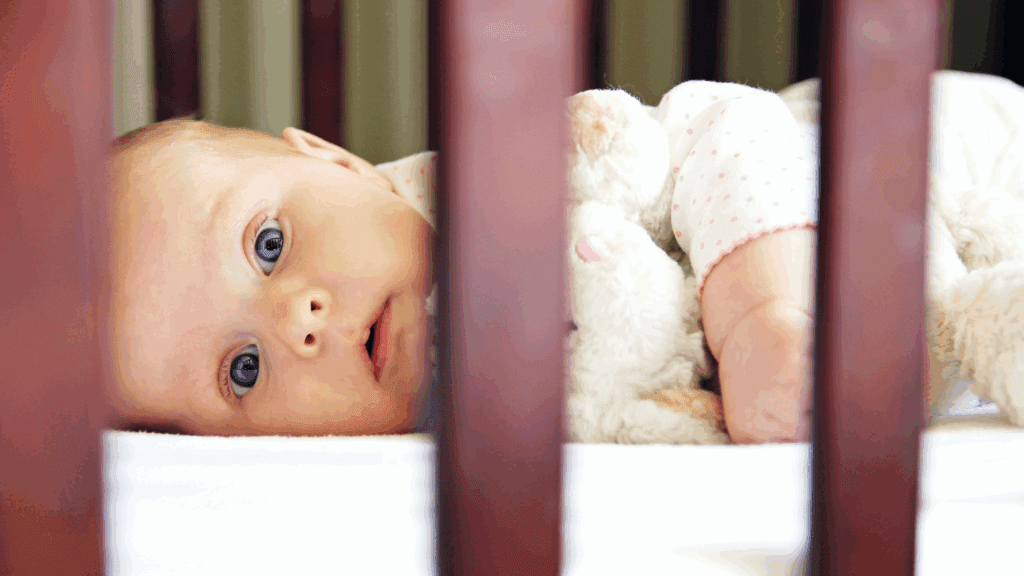Watching your newborn struggle to sleep can be everything from overwhelming and exhausting to heartbreaking. One of the most popular newborn sleep tips is to let babies ‘cry it out’, but let’s be honest, that thought is not for everyone.
If you’re one of those parents who don’t want to let their baby cry it out, this blog is for you. We’ve gathered nine gentle, research-backed newborn sleep tips to help your baby drift off without tears. Keep on reading!
You Might Also Like: The SNOO Smart Sleeper
1. Establish a Soothing Bedtime Routine

Use a consistent bedtime routine to set expectations and cue your newborn that sleep time is near.
- Dim the Lights & Quiet the Day: Lower lighting and minimize talking 30 minutes before bedtime, to signal night mode.
- Use Simple Rituals: Try a warm bath, gentle massage, or lullaby. Performing the same sequence every night helps build familiarity. This not only builds a routine but also gives the child a sense of safety.
- Feed & Diaper Change: A full tummy and fresh diaper reduce midnight wakings due to hunger and discomfort.
Explore: Renting vs Buying Used Baby Gear: Which is Best for Your Family?
2. Swaddle for Security and Comfort

Swaddling is one of the oldest newborn sleep tips, dating back to 4000 B.C. and is rooted in ancient cultural traditions from all over the world. It mimics the womb’s snug environment making newborns feel secure while limiting the startle (Moro) reflex.
- Use Lightweight, Breathable Fabric: A proper swaddle (e.g., a muslin wrap) keeps your baby snug without being overheated.
- Ensure Hip-Healthy Positioning: Keep legs flexed and slightly apart to prevent hip dysplasia. According to the Hip Dysplasia Institute, babies should be swaddled with ‘frog legs’ as in the womb, and not straight legs.
- Transition When Rolling Begins: Once your baby shows signs of rolling (typically around 2-4 months), switch to a sleep sack to maintain safety. Common signs of rolling include side-to-side rolling of hips and controlled lifting of the head, shoulders, or body.
Cover play and sleep in one package for cost- and space-efficiency with the Pack & Play rental.
3. Practice Responsive Settling

Responsive settling means comforting your baby instead of letting them cry alone. With responsive settling, you respond to your baby’s needs with gentle strategies to give them longer stretches of sleep.
- Hold & Soothe in Your Arms: If your baby fusses, pick them up and rock gently or sway while speaking softly to reassure them you’re there.
- Use Gentle Touch: A light hand on the baby’s chest or back can calm them until they drift off.
- Put Them Down Drowsy But Awake: Let your child learn to self-soothe with your support nearby. Give them time to settle down, maintain gentle contact until their eyelids begin to droop, and then set them in their crib.
Planning a trip? Put your baby to sleep anywhere with this blackout sleep tent for babies.
4. Differentiate Daytime from Nighttime

Newborn circadian rhythms take some time to develop, and thus, helping them differentiate day from night can play a key role in encouraging better sleep.
- Bright Days, Dim Nights: Expose your baby to natural light during the day. Open curtains and take short walks during the day, and at night, keep lights low and quiet.
- Consistent Wake Time: Aim for consistent morning wake times (e.g., between 6–8 a.m.) so their internal clock syncs to a 24-hour rhythm.
- Differences between Day Naps vs. Night Sleep: Reserve swaddling for nightime sleep only. For daytime, it is better to give naps with some light in the room. You can also use different kinds of sleep sounds for day vs. night time sleeping.
Check Out: Inflatable Bed Rail Rental for Safe Sleeping Anytime, Anywhere
5. Introduce Gentle Soundscapes

Soft, continuous sounds can mimic in-utero noise, helping babies stay asleep without distress. This is a common modern baby sleeping tip practiced widely today.
- White Noise Machines: Devices like a white-noise machine or a fan can block disruptive sounds and soothe infants.
- Lullaby Playlists: Use a preloaded lullaby playlist or gentle nature sounds to create a calming backdrop.
- Volume at Safe Levels: Keep noise at or below 50 dB, about the sound of a quiet conversation.
Consider the SNOO Sleeper as a rental to help your baby sleep calmly with automatic gentle rocking and soothing sounds.
6. Optimize the Sleep Environment

A safe, clutter-free sleep space reduces SIDS (Sudden Infant Death Syndrome) risk and helps babies self-soothe. A safe space should be firm, flat, levelled, and mess free.
- Back Sleeping Only: Always place babies on their backs in a crib or bassinet; never on stomach or side.
- Clear Crib, Firm Mattress: Use a tight-fitting sheet and avoid pillows, toys, or loose blankets. Soft bedding can increase risks of rolling, suffocation, or positional asphyxia.
- Optimal Room Temperature: Keep the nursery temperature between 68°F–72°F (20°C–22°C) so baby doesn’t overheat.
Sleeping in separate rooms? Monitor your baby with this wireless baby video monitor.
7. Monitor Wake Windows & Feeding Schedules

Newborns can only stay awake 45–60 minutes before they get overtired. Monitoring sleep and wake times can help you understand your baby’s behavior better to put them to sleep easily.
- Short Awake Periods: Observe sleep cues like eye rubbing, yawning, and fussiness, and then aim to initiate naps within 30 minutes. Putting babies down when they want to sleep will make sleep time easier for you – and your baby will also be happier and well rested when awake.
- Cluster Feeding Evenings: Offer extra feeds between 5-8 p.m. to fill them up and reduce nighttime hunger-induced wakings.
- Late Feed for Longer Sleep: A late-evening feed while the baby is still semi-asleep can extend stretches up to 4 hours.
Check Out: Secondhand SNOO Survival Guide
8. Use a Consistent Sleep Phrase

Babies respond well to repetition, and hearing the same calming words each night can become a powerful sleep cue.
- Pick a Simple Phrase: Something like “It’s sleepy time now” or “Night-night, little star.” can be a good sleep phrase.
- Repeat Softly: Babies are sensitive to tone, so say the phrase gently and multiple times before and during your bedtime routine.
9. Prioritize Parent Self-Care & Support

Your well-being directly affects your baby’s sleep. Well-rested parents are better able to understand their children and respond calmly and consistently.
- Nap When Baby Naps: If you’re sleep deprived, nap every chance you get. Even a 20-minute nap will boost your energy and improve nighttime responses.
- Share Nighttime Duties: If possible, trade off night wakings for baby feeding or soothing with a partner or trusted caregiver so you both get extended rest.
- Seek Professional Advice: If sleep struggles persist, consult a paediatric sleep specialist to rule out reflux, colic, or other issues.
Sleep more. Worry less. Explore high-end rental baby gear to help your little one snooze soundly and comfortably.
FAQs (Frequently Asked Questions)
Q. Is it safe to use white noise for every nap and bedtime?
- Yes, but remember to keep the volume around 50 dB and place the machine at a safe distance (around 7 feet) from the crib to prevent hearing issues.
Q. Can I swaddle my baby all night long?
- Yes, it’s safe to swaddle all night long as long as you’re swaddling safely, in the right position without being too tight around the hips. It is also important to place the baby on their back when sleeping.
Q. What if my baby wakes frequently at night despite these tips?
- Frequent night wakings are normal and natural for newborns due to their short sleep cycles. Continue responding promptly and consider a dream feed before you sleep to extend stretches.
Q. Should I wake a sleeping baby for a feeding?
- Yes, it’s okay to wake up a baby for feeding. It’s important if they haven’t regained their birth weight or aren’t gaining weight consistently. If they sleep for longer durations, waking them up for feeding is important to prevent them from going hungry for long hours.
Q. How much daytime sleep should my newborn get?
- Newborns typically sleep around 14–17 hours a day, with about 3-6 naps lasting 30 minutes to 3 hours each. It’s normal if this varies a bit. Focus on making the environment calm and predictable rather than having strict schedules.

